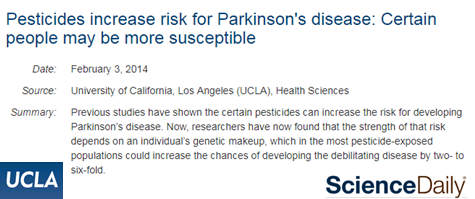HYPE?
Media portrayal:

HOPE?
Scientific interpretation:
Pesticides linked to increase in Parkinson’s risk
Original article: Aldehyde dehydrogenase variation enhances effect of pesticides associated with Parkinson’s disease. Neurology: November 11, 2014
The takeaway
Pesticides that inhibit an enzyme called ALDH increased Parkinson’s disease risk two- to six-fold. The effect was particularly marked in people with genetic susceptibility to the disease.
Why is it important?
The study helps explain how factors in a person’s environment may increase risk of developing Parkinson’s and opens the door for potential ways to mitigate that risk, including reduced exposure to pesticides and development of drugs that target the underlying mechanisms that contributes to risk.
%
IMPACT
- Novelty 85%
- Proximity 45%
- Deliverability 71%
Impact
“The notion that pesticides play a role in triggering Parkinson’s became popular in the 1980s. This study provides new revelations about pesticides as a contributor to PD and how mild genetic risk might interact with exposure to pesticides to result in the onset of symptoms.” Dr. Patrik Brundin
Background
Exposure to pesticides has long been linked to an increased risk of developing Parkinson’s disease. This effect is particularly marked in farmers, who tend to have greater exposure to pesticides than the general population (you can read a summary of one recent study here).
The details
To see if pesticides impacted ALDH in the brain, researchers used experimental lab models and investigated the pesticide exposure of 360 people with Parkinson’s and 816 controls in three counties in rural California.
Out of 26 pesticides they tested in the lab, researchers found 11 that interfered with ALDH’s ability to do its job. When ALDH isn’t working properly, a chemical called DOPAL accumulates in brain cells, leading to damage and cell death.
Of the 11 pesticides identified, researchers were able to study eight by looking at the medical histories of people who were exposed to them, based on a pesticide use records for three counties in California. These eight were associated with increased risk in Parkinson’s. Given the available data, it was not possible for researchers to attribute this affect to any one of the eight pesticides individually or to totally account for exposure to other pesticides.
They also noted increased risk for people with a variation of ALDH called ALDH2, which further supports the link between environmental and genetic risk of Parkinson’s disease.
Related work
A recent study investigated the association between agricultural characteristics and incidence of Parkinson’s using the French National Health Insurance databases (2010-2012). They identified 69,010 incidences of Parkinson’s and found that higher incidences of Parkinson’s were associated with rurality, particularly in areas with a high density of vineyards. This association was present in all French regions and was similar in men, women, and non-farmers but stronger in older people. The study suggested that because vineyards in France require intense pesticide use, pesticides exposure is a possible explanation for the higher risk of Parkinson’s found in these areas.
Where can I learn more?
Original article: Fitzmaurice AG, Rhodes SL, Cockburn M, Ritz B, Bronstein JM. November 11, 2014. Aldehyde dehydrogenase variation enhances effect of pesticides associated with Parkinson’s disease. Neurology 82(5):419–426.



